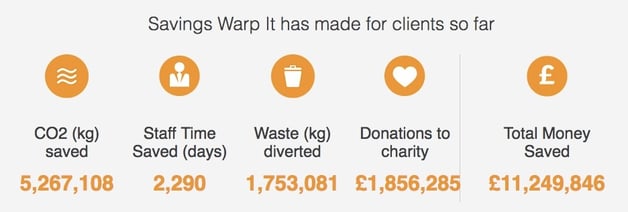Warp It would like to introduce Nick Fayers for your reading pleasure. Nick is the Divisional Energy and Environmental Manager at Nottinghamshire Healthcare. He’s a wealth of knowledge when it comes to:
- Asset reuse in a large bureaucratic organisation
- Making the case for the continued investment in reuse
- Dealing with organisational structural problems when you are pushing for one objective
Nick’s experience with implementing reuse in Nottinghamshire Healthcare has been challenging but rewarding, as you’re about to learn. Some of the challenges are organisational issues that highlight some vitally important procedural barriers that need to be overcome. Which are worth highlighting!
We are grateful to Nick for being so transparent on the issues, in such a way that for those of you reading this, you can learn better what not to do.

Hi Nick, you’ve been on Warp It for a year and a half now, can you tell us a bit about your journey?
Well, we launched over Christmas. We'd already tried something similar that was nowhere near as good. I was asked to set up the Warp It system, get it going and then hand it over to to another department, which is how my entire team understood it, but it’s not quite how it turned out. We had a really good first few months and handover got put to one side. Then when it came time to give it over, the other dept said, "No, that's your project to manage”. For us, that was a bit of a shock, because everyone on our team knew that one thing was agreed, but obviously we were the only ones who knew it!
Why were they reluctant to take on the project in the department?
Time pressures. What they saw was just something else they would have to manage and they didn't want to do it because they believed it was going to be a time-consuming job, and they didn't have the manpower to do that, which is fair.
In the end, we managed to sort everything out, so now we just log in and check for problems or complaints and that’s about it. The good news is that the department have agreed that Warp It will be their project, but we haven’t handed it over yet.
If you could go back in time, how would you do things differently? Would you have launched the program a different way?
I think the big problem we experienced is that we needed to have a all the players involved at the start, because we knew the main players and administrators were going to change. We needed a written agreement, because we had meetings and some of the stakeholders made agreements, but then issues arose.
There's certainly no disagreement that Warp It is a worthwhile system, it just needs to be in the right hands, as we don’t want it to fail. I don't want to hand it over, but I'm not a furniture management person, so it doesn't need to be on my books.

So, if the first year didn’t quite go to plan, and there were problems about who was running the show, how did you manage to convince senior management to subscribe for another year?
A bit of luck, as the powers that be in procurement agreed that it’s worthwhile. I had to download the transactions list, compare it with staff records and identify where the benefits had been made and in which division. I’ll have to continue doing this for the second year of Warp It, in a sort of ongoing review process. It’s an interesting way of approaching it, but it just reaffirms my point about how this should be a centralised project. I need to build a list of everyone involved and we have to answer these questions: How will this be paid for? How will the benefit be accounted? Who will manage the systems? Who will promote the system?"

So what you’re saying is, during the implementation meeting you have to make strong commitments for the first and second years so that you don’t face these sorts of hurdles. That’s good advice. Regarding your issue of finding which departments are saving the most money, we can build you a feature that tracks that and visualises results in a table.
That would be great! I know you compare organisations against each other, but an internal competition would be good. However, it might encourage claiming for the sake of points, which might not be good, but people would manage it responsibly, I’m sure.
Are you working with anyone involved with building clearances and capital development?
We are trying to. Our building clearance team doesn’t exist at the minute, which is part of the problem. We are working with our portering team at the minute. What we are saying to the person now in charge is that when they do a clearance or are asked to take stuff away, they should ask if it’s possible to put the good stuff on Warp It. If there is good stuff when they go to collect things, they’re not going to take them and throw them away, as they know that they can be claimed and save the organisation some money.
Key learnings are:
- Get an agreement for responsibilities on paper from all stakeholders at the start of a reuse project.
- Make the agreement public - you might want to do a picture and internal news item.
- Recognise the landscape changes during a project and you might need to account for some slack in the team.
Thank you so much for your time and transparency Nick. It’s clearly not always plain sailing when introduce a surplus asset sharing system or a reuse programme, but in the end, it will always be worth it.
Trying to convince the main players that they can be a huge driver in your reuse project? Look no further!









